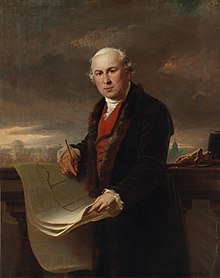James Gandon
| James Gandon | |
|---|---|
 |
|
| Born | 20 February 1743 New Bond Street, London |
| Died | 24 December 1823 (aged 80) Drumcondra, Dublin Ireland |
| Resting place | Drumcondra Church, Drumcondra, Dublin, Ireland |
| Occupation | Architect |
| Known for | Architect of Four Courts, The Custom House, King's Inn, Dublin, Ireland |
James Gandon (1743–1823) is today recognised as one of the leading architects to have worked in Ireland in the late 18th century and early 19th century. His better known works include The Custom House, the Four Courts, King's Inns in Dublin and Emo Court in County Laois.
Gandon was an English architect, born on 20 February 1742 in New Bond Street, London, at the house of his grandfather Peter Gandon, a French Huguenot refugee. He was the only son of Peter Gandon (b. 1713), a gunmaker, and Jane Burchall (possibly née Wynne). From 1749 he was educated at Shipley's Drawing Academy where he studied the classics, mathematics, arts and architecture. On leaving the drawing academy he was articled to study architecture in the office of Sir William Chambers. Chambers was an advocate of the neoclassical evolution of Palladian architecture, although he later made designs in the Gothic Revival style. However, it was Chambers's palladian and neoclassical concepts which most influenced the young Gandon.
In 1765, Gandon left William Chambers to begin practice on his own. His first commission was on Sir Samuel Hellier's estate at the Wodehouse, near Wombourne. Gandon's new practice, whilst successful, always remained small. In about 1769 he entered an architectural competition to design the new Royal Exchange in Dublin. The plan eventually chosen was by Thomas Cooley. However, Gandon's design came second and brought him to the attention of the politicians who were overseeing the large-scale redevelopment of Dublin, one of the largest cities in Europe at the time.
During the following years in England, Gandon was responsible for the design of the County Hall in Nottingham. Between 1769 and 1771, he collaborated with John Woolfe on two additional volumes of Vitruvius Britannicus, a book of plans and drawings of Palladian revival buildings by such architects as Inigo Jones and Colen Campbell. During his English career he was awarded the Gold medal for architecture by the Royal Academy, London in 1768.
...
Wikipedia
